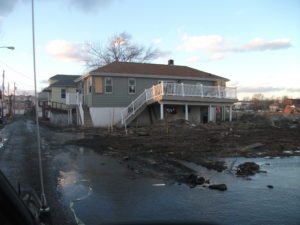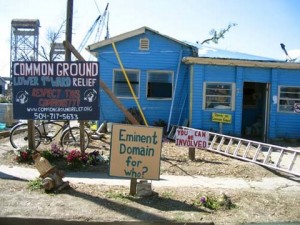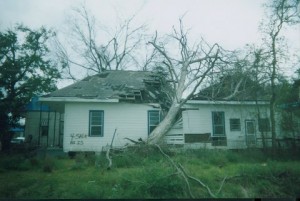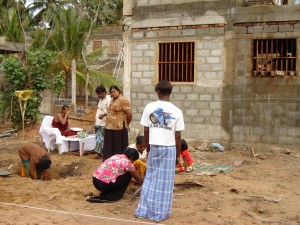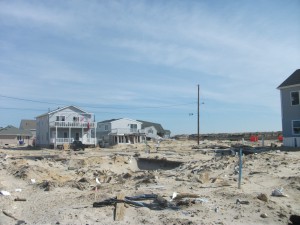One of the ongoing, perhaps permanent, struggles in public policy in a democracy like ours involves finding a balance between enabling private sector opportunities and protecting both the public interest and the public purse. Depending on their philosophies and perspectives, people will naturally draw those lines in different places on different issues. But sometimes it is perfectly clear when the public interest is about to suffer a hit. Currently, one of those possibilities involves the fate of the National Flood Insurance Program (NFIP).
On April 28, the U.S. House of Representatives passed HR 2901, a bill that seeks to make it easier for private companies to write private flood insurance policies that can take the place of those provided by the NFIP. The NFIP was created under the National Flood Insurance Act of 1968 to provide insurance that was then largely unavailable on the private market, but it also set in motion the creation of a federal regulatory program that has established standards for floodplain management in more than 22,000 communities nationwide. Many of those communities, particularly smaller ones, have no other meaningful land-use regulations, unlike bigger cities and suburbs and communities in states that mandate planning, which typically have comprehensive plans, zoning ordinances, and subdivision regulations. The reason is that federal flood insurance is made available only in communities that have adopted the minimum standards of the NFIP, which seek to achieve flood loss reduction, thus reducing the damages from flooding and the resultant payouts under flood policies.
It makes perfect sense. There is no good reason for the federal government to insure properties against flood losses without making some attempt to minimize those losses through sensible land-use measures. Private casualty insurers certainly make attempts within their means to reduce losses from other types of accidents and disasters. Why not the federal government?
There is nothing inherently wrong with expanding opportunities for private flood insurance coverage. But there are serious issues with HR 2901, and the Association of State Floodplain Managers (ASFPM), an organization with which I work closely as manager of the Hazards Planning Center at the American Planning Association (APA), has mounted an alert among its members to urge U.S. Senators to take time to examine the bill closely before taking any action this fall. It has also addressed the issue earlier in testimony before the Senate Committee on Small Business and Entrepreneurship. The Senate is in recess until September 6. ASFPM would ideally prefer that Congress defer action until next year, when the NFIP is due for reauthorization in any case, in order to consider the unintended consequences of the House bill in line with the larger objectives of the NFIP. APA is in support of the ASFPM effort in this regard.
The NFIP has evolved for nearly half a century with numerous revisions and reforms over time. Like any such program, it has needed to evolve in response to new lessons and changing circumstances. Some of the most significant lessons of the past came from the 1993 Midwest floods, which spawned reforms a year later. Among numerous changes that year was modification of policies to include Increased Cost of Compliance, which allows policies to pay for building improvements in response to higher local building standards, for example, by requiring elevation of buildings above the Base Flood Elevation, which is basically the height of the 100-year, or one percent chance annual flood, as mapped on the NFIP’s Flood Insurance Rate Maps. It is in the public interest to facilitate the capacity of communities to upgrade such codes over time as new lessons are learned, and to make it financially feasible for policy owners to comply with those new standards when rebuilding after a flood.
To be sure, these maps have never been perfect indicators of flood risk, though they are getting better with current digitization initiatives. Still, only about 1.2 million miles of shoreline and riverfront have been mapped, while more than 2/3 of the miles of the nation’s waterways are not. Most of the latter are small creeks and streams outside developed areas, which clearly have always been the priority. But it also means that development can occur in less developed areas without requirements to meet standards that only apply to mapped floodplains—unless a local jurisdiction is proactive enough to require developers to map such areas before new subdivisions or other development can be considered. Mostly, that is not the case.
So what is at issue with HR 2901? For one thing, NFIP policies include a policy fee that helps underwrite the cost of all this mapping, including updates and corrections over time. It is an ongoing process in part because floodplains are not static geographic entities. They expand or contract with the impact of our development practices, which affect the amount of impervious surface in urbanized areas, which affect how stormwater and other runoff is absorbed into the ground or directed downstream. Further, according the Federal Emergency Management Agency (FEMA), about 40 percent of flood-related losses occur outside mapped floodplains. Why? Because not all floodplains are adequately mapped or as yet mapped at all, and because flooding can occur outside and beyond the 100-year floodplain, and often does. We have Certified Floodplain Managers these days because this is, in fact, a complex and technical subject.
The problem with not including policy fees in the private policies is that the burden of financing this public good of mapping floodplains and maintaining a mountain of data about flood hazards falls to those NFIP policyholders who are paying for it, or to the American taxpayer when Congress allocates money directly for the purpose. The fee also supports flood hazard reduction efforts under FEMA’s Flood Mitigation Assistance program. That creates an inequity in favor of private flood insurance. But that is not all. Although federal financial regulators have had authority to establish policies concerning what provisions in a private policy would make them acceptable as an alternative to an NFIP policy, they have not acted. FEMA legal advisors, for whatever reason, decided in 2013 they did not have the authority to issue guidance. So the House bill assigned this responsibility to state insurance commissioners while prescribing that lenders and federal bank regulators “shall accept” the standards laid out by the states. It would be small surprise to anyone knowledgeable in this field to discover that state regulation in most cases is likely to be minimal and limited. The only required equivalency in the House bill will deal with the coverage amount, which may result in much smaller private premiums with high deductibles that may be superficially attractive—until homeowners with large deductibles find they lack the resources to rebuild and just walk away, quite possibly leaving communities and the federal government holding the bag for addressing the problems of neighborhoods with spotty redevelopment and blighted properties.
All of this, at the very least, deserves some serious debate before the Senate accepts the House version, but proponents have been seeking to fast-track the Senate bill (S 1679) under a process known as Unanimous Consent. However, if enough Senators hear enough complaints, fast-track may become a less attractive option. And, as noted earlier, there are good reasons to delay this discussion and take it up as part of the NFIP reauthorization next year, so that both Senators and the public can begin to understand the full implications of what has been proposed.
In no way would this be a death knell for private flood insurance. One problem the bill deals with in two useful paragraphs is to allow the private policies to be considered “portable” for the purpose of maintaining an unbroken record of coverage for a property if the owner switches between public and private insurance. That has not been the case but is not hard to fix. ASFPM notes that there has been a doubling in the last couple of years of companies offering private insurance. In other words, the expansion of private flood insurance is already happening. There is no reason to create a whole class of private policies that are not truly equivalent to those of the NFIP and, in the process, undermine the public goods produced by the NFIP and quite likely, increase the number of property owners seeking disaster assistance after discovering they are inadequately covered.
Flood insurance policy has already entered a volatile period that began with the Biggert-Waters Flood Insurance Reform Act of 2012, passed just a few months before Hurricane Sandy. While trying to place older, subsidized policies on a path to actuarially justifiable rates, it triggered a political backlash when rates began to soar after the impact of Hurricane Sandy. By 2014, Congress somewhat reversed course but has left unresolved a number of issues concerning how previously subsidized policyholders could afford their now escalating premiums as Congress sought to reconcile affordability with a desire to place the NFIP on a fiscally sound footing. It is a thorny issue at best, and we surely have not heard the end of it. The simple fact is that large numbers of older, poorly protected properties in or near floodplains are likely to continue to generate flood losses into the future.
We already have a flood insurance program that is $23 billion in debt to the U.S. Treasury because of Hurricanes Katrina and Sandy, which overrode assumptions that the NFIP would largely insure garden-variety disasters. Next year’s reauthorization could sensibly forgive this debt in order to begin to place the NFIP back on a fiscally sound footing, but not with the approaches in HR 2901. We need to strengthen, not weaken, a system that at least drives toward stronger floodplain management and flood mitigation. We need to get this train moving again in the right direction. Congress needs generally to be more productive than it has been in recent years, but it also needs to put more thought into this particular issue and act in less haste. The alternative is to continue to generate a long train of unintended consequences and later ask what happened and why.
Jim Schwab

